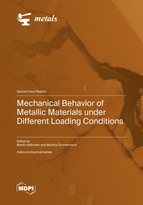Mechanical Behavior of Metallic Materials under Different Loading Conditions
A special issue of Metals (ISSN 2075-4701). This special issue belongs to the section "Metal Failure Analysis".
Deadline for manuscript submissions: closed (30 September 2022) | Viewed by 30869
Special Issue Editors
Interests: high temperature alloys; intermetallics; high entropy alloys; strengthening mechanisms; creep; directional solidification; powder metallurgy
2. Technical University Dresden, Dresden, Germany
Interests: deformation behavior of metals and composites; fatigue behavior; microstructure/Properties correlation; damage mechanisms; failure analysis; lightweight structures and joinings
Special Issue Information
Dear Colleagues,
Metallic materials are most frequently used in structural applications under various loading conditions. This Special Issue is dedicated to Prof. Hans-Jürgen Christ, University Siegen, Germany, who, throughout his career, has made seminal contributions to the fatigue and fracture of metals and alloys at various loading rates, temperatures, and within harsh environments. Therefore, we seek contributions that present new results and findings on the deformation behavior of single- and multi-phase (particle-strengthened) metallic materials, including metal matrix composites, particularly research addressing underlying microstructural mechanisms and consequences of material design and application. In addition, papers that address monotonic and cyclic deformation behavior (including the VHCF regime) at low and elevated temperatures in various environments, and studies on fracture mechanisms, are welcome.
Prof. Dr. Martin Heilmaier
Prof. Dr. Martina Zimmermann
Guest Editors
Manuscript Submission Information
Manuscripts should be submitted online at www.mdpi.com by registering and logging in to this website. Once you are registered, click here to go to the submission form. Manuscripts can be submitted until the deadline. All submissions that pass pre-check are peer-reviewed. Accepted papers will be published continuously in the journal (as soon as accepted) and will be listed together on the special issue website. Research articles, review articles as well as short communications are invited. For planned papers, a title and short abstract (about 100 words) can be sent to the Editorial Office for announcement on this website.
Submitted manuscripts should not have been published previously, nor be under consideration for publication elsewhere (except conference proceedings papers). All manuscripts are thoroughly refereed through a single-blind peer-review process. A guide for authors and other relevant information for submission of manuscripts is available on the Instructions for Authors page. Metals is an international peer-reviewed open access monthly journal published by MDPI.
Please visit the Instructions for Authors page before submitting a manuscript. The Article Processing Charge (APC) for publication in this open access journal is 2600 CHF (Swiss Francs). Submitted papers should be well formatted and use good English. Authors may use MDPI's English editing service prior to publication or during author revisions.
Keywords
- metals
- alloys
- particle strengthening
- fatigue (LCF, HCF, VHCF)
- creep
- fracture mode







